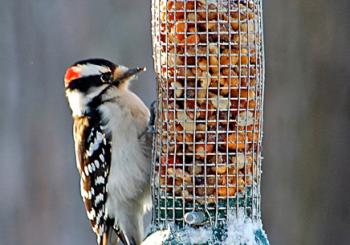Birds On Alert

Downy Woodpecker
Photo Credit: Val Cunningham
by Val Cunningham
Contributing Writer
Why Feeder Birds “Freeze” or Scatter
Danger can lurk in the backyard, and birds are always on the alert for signals that put them on the defensive.
One minute the little downy woodpecker was pulling peanuts out of a feeder, the next he seemed frozen in place, moving nothing except his eyeballs. What caused this sudden change, from activity to immobility?
And where did all the other backyard birds go, the ground-feeding sparrows, the seed-snatching chickadees and the flock of goldfinches at the tube feeders?
Danger was around and they’d all seen or sensed it.
Since woodpeckers aren’t fast flyers, the downy’s best defense was to freeze in place. If a predator was on the hunt for a meal, the downy couldn’t count on making it safely to a tree or shrub. His best defense was to be as still as possible, hoping to escape a predator’s notice.
The other birds — faster flyers — knew that their survival depended on leaving the area fast, and they all scattered at the first hint of danger. The sparrows jammed into an evergreen shrub, the chickadee headed for a nearby dogwood and the goldfinches sped to the top of a tall maple.
All the birds had either seen a shadow pass overhead or had heard another bird calling a high-pitched, nearly inaudible danger signal. Looking like part of a feeder or getting out of harm’s way were their bids for staying alive.
Freeze or flee
This sudden disappearance of all the backyard birds happens several times a week around my feeders, and probably at yours, too. What kinds of predators make them scatter so quickly, or freeze in place? First and foremost, they’re afraid of bird-eating hawks, the Cooper’s and sharp-shinned hawks. While most of these hunters may have left our area for winter, there always are a few prowling around, and since each hawk consumes hundreds of small birds a year, wariness is a good survival tactic.
Another source of danger is free-roaming cats, the scourge of the bird world. The ground-feeding birds, from mourning doves to cardinals to sparrows, fly up in alarm if a cat is detected in the vicinity. Other threats to survival include the northern shrike, a robin-sized bird with a taste for smaller birds. Shrikes often use birds’ own fleeing tactics against them, driving them toward a house’s windows, then scavenging any that hit and fall to the ground.
A bird that sees a hawk or cat itself has first-hand information both about the level of threat and about when it’s safe to resume feeding. But birds that have only heard a danger call are dealing with second-hand information — they don’t know what the threat is, so must respond as if their lives are on the line. And since they don’t know when the danger is past, they hide for a longer period.
Cunning jays
One bird known to take advantage of other birds’ response to danger calls is the raucous blue jay. A jay will sometimes fly toward feeders, making its loud alarm call. As the smaller birds scatter in fear, the clever jay then can feed in solitary comfort.
Birds can become inured to a threat. For example, if a blue jay “cries wolf” too frequently, other birds may begin to ignore its alarms. And a reader sent in an intriguing question: why do his backyard blue jays and cardinals seem indifferent to a red-tailed hawk that frequently perches in the pines near his feeders? The reason is that the songbirds have become habituated to the hawk after noticing that he never attacks them, only the voles that scurry beneath the feeders.
You’ve noticed how wary birds are when out in the open: they’re always casting glances to the side and overhead to spot any danger. When many birds are feeding at once in an area, having many eyes on the alert for threats can give birds an edge.
One way to make your backyard safer for birds is by providing places for them to take shelter (see tips below). Activity around feeders can attract the attention of predators but having a “bolt hole” helps birds even the odds.
Taking cover
Backyard birds appreciate places to hide from danger, also known as cover. Consider these suggestions:
- Plant mid-sized trees and dense shrubs near feeders—but not so close that they shelter marauding hawks and cats. Plant vegetation 10 feet or more from feeding stations.
- Bunch feeders in one or two areas, so birds can help each other by serving as sentries.
- Build a brush pile to shelter birds from danger and the elements. Start with your discarded holiday tree, then add old branches and plant debris.
- Scatter seed under sheltering evergreen trees and shrubs for ground-feeding birds.
- Keep feeders close (within 3 feet) so startled birds don’t build momentum, or far enough away (30 feet. or more) from the house, so they have time to avoid windows.
St. Paul, Minnesota resident Val Cunningham, leads bird hikes for the St. Paul Audubon Society and writes about nature for local, regional and national newspapers and magazines.



